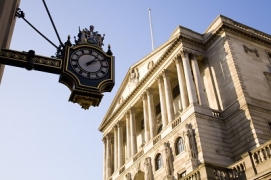Archived article
Please note that tax, investment, pension and ISA rules can change and the information and any views contained in this article may now be inaccurate.

The Bank of England has voted to cut interest rates for the first time in four years, meaning the country’s official rate has fallen from 5.25% to 5%. The Monetary Policy Committee, which makes the decision, saw five members vote for a cut and four vote to keep rates unchanged – making it a tight vote.
What does this mean for future interest rates?
Anyone hoping the rate cut will mean interest rates are going to drop dramatically and fall back to low levels is likely to be disappointed. There is no expectation that this interest rate reduction signals the start of a series of rapid and chunky cuts to rates, instead the Bank is likely to make one more cut this year and take a wait-and-see approach each time. The Bank itself has cautioned there are a number of factors that could change the data and turn the tide against future rate cuts.
The energy price cap is expected to rise this winter, public sector pay agreements might push up prices, and a second Trump presidency in the US could stoke further global inflation through tax cuts, tariffs, and tough immigration controls. There is little room for central bank complacency. Indeed, the Bank of England expects inflation to creep up towards 3% again towards the end of this year. Hence why four members of the Bank’s interest rate committee voted to keep rates on hold.
But the 1 August rate cut is more symbolic than material, as a 25-basis point cut is not going to have a dramatic impact on anyone’s finances. People will be buoyed by the fact interest rate hikes are behind us and that after a year of rates being over 5%, they have finally been cut. Having interest rates on a downward path will also help the new chancellor balance the books, though government debt interest payments are still uncomfortably high.
Even if more rate cuts are forthcoming, no-one should be under any illusion that rates are going back to near zero. And, as ever when it comes to interest rates, it’s best not to count your chickens until they’re hatched.
What does it mean for mortgages?
We’ve already seen some movement in the mortgage market, with providers launching sub-4% rates ahead of the interest rate cut, and others will follow suit as competition heats up again in the market.
Someone with a £125,000 tracker mortgage over 25 years should see around a £17 drop in their monthly payments following the 0.25% cut in the Bank of England official rate, while someone with £400,000 of borrowing over 25 years should see around £56 chopped from their monthly repayments – amounting to around £670 a year off their mortgage bill.
There are 700,000 fixed rate mortgage deals due to end in the second half of this year, according to UK Finance, meaning there are many homeowners who could benefit from the interest rate cut. While it’s not certain that mortgage rates will drop as a direct result of the Bank of England’s actionst, we’re likely to see mortgage rates head down from here.
Any homeowners with a fixed-rate deal ending soon should make sure they know the date it’s expiring and lock in a new deal six months ahead of that date. If rates fall during that six-month period you can switch to a cheaper deal, but it means you’ve got an insurance rate locked in.
It’s crucial that anyone who has fallen onto their lender’s Standard Variable Rate (SVR) deal looks at a new mortgage deal. While these rates are likely to fall after the Bank of England’s reduction in the official rate, on average customers are paying 7.8% for their SVR – the highest rate a mortgage company will offer. A majority of these customers will be able to secure a new, lower-rate mortgage and could save thousands each year by doing so.
What does it mean for savings rates?
The move to cut the country’s official interest rate means we’re now past peak interest rates. Any savers wanting to lock in a top deal should get their skates on. Average cash savings rates in non-ISA accounts have dropped slightly this year, according to Moneyfacts data, but with a Bank of England cut we’re likely to see a further drop.
Anyone who wants to get the best savings rate should shop around – searching on trusted comparison sites or cash savings hubs to find the best rate possible. They can filter their search if they want to bank via post or in branch, and whether they want to lock in a fixed-term deal or have easy access to their money.
However, with cash rates falling, savers should also consider whether they have too much cash and if instead they should take on investment risk in search of better long-term returns. Figures from HMRC show 3 million people have more than £20,000 held in a Cash ISA, but haven’t put anything into a Stocks and shares ISA.
Ways to help you invest your money
Put your money to work with our range of investment accounts. Choose from ISAs, pensions, and more.
Let us give you a hand choosing investments. From managed funds to favourite picks, we’re here to help.
Our investment experts share their knowledge on how to keep your money working hard.

